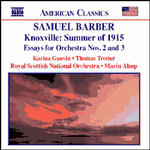
Barber: Knoxville: Summer of 1915, Op 24 / Toccata Festiva, Op 24
 $25.00
Out of Stock
$25.00
Out of Stock6+ weeks add to cart
SAMUEL BARBER
Barber: Knoxville: Summer of 1915, Op 24 / Toccata Festiva, Op 24
Karina Gauvin (soprano) Thomas Trotter (organ) / Royal Scottish National Orchestra / Marin Alsop
[ Naxos American Classics / CD ]
Release Date: Thursday 20 May 2004
This item is currently out of stock. It may take 6 or more weeks to obtain from when you place your order as this is a specialist product.
"A Knoxville performance to treasure as this essential Barber series reaches a new high point"
Gramophone Magazine Recording of the Month (June 2004)
"Samuel Barber's Knoxville: Summer of 1915 is a magical work: once heard, difficult to forget. I first got to know it in Leontyne Price's opulent RCA version and became further drawn into its world by Dawn Upshaw's more childlike, wide-eyed view on Nonesuch: this new Naxos disc is something of a revelation. Karina Gauvin is a young Canadian soprano - check out the Analekta and Dorian catalogues for more of her recordings, especially of Baroque repertoire. She takes a wonderfully innocent approach, beautifully accompanied by our current Artist of the Year whose uncovers all sorts of ear-tickling orchestral details. Marin Alsop is also excellent in the two Essays for orchestra, works written for no less than Bruno Walter and Eugene Ormandy."
(Gramophone)
The music of Samuel Barber has always managed to elude critics and scholars, largely because he was never part of a particular school, aesthetic, or dogma in the midst of a tumultuous century where composers defined themselves by artistic camps. The reductive term "neo-romantic" is conveniently attached to Barber's work, yet there was nothing "neo" about him-rather, Barber was the last of the true romantics, an American equivalent to Sibelius or Elgar, but with a richer craft, a craggier surface to his work, and a more curious, far-reaching mind.
Barber was born in Westchester, Pennsylvania in March 1910, and showed great promise from an early age, composing some rather impressive, large-scale pieces under the tutelage of composer Sidney Homer, who doubled as his uncle. In 1924 he entered the Curtis Institute as a member of its first class, where he not only studied composition and piano, but also became quite a good baritone. So impressive was he that his fellow students, in awe of his prodigious talent and keen intellect, spoke without irony of the three "B's", "Bach, Beethoven, and Barber."
Barber would go on to be one of the most feted composers of his day, winning two Pulitzer Prizes and the Prix de Rome, and receiving commissions from the world's most established musical institutions, most notably the Metropolitan Opera, but the failure of his second opera, Antony and Cleopatra, eventually curtailed his otherwise rather prolific output. In the end, watching post-Webernian composers like Boulez and Carter rise to prominence, observing his own evolving obsolescence, made him into a somewhat reclusive, tragic figure. He died in January 1981 in New York City.
In 1942, Barber was commissioned by Bruno Walter to compose a work for the New York Philharmonic, and he obliged with his Second Essay for Orchestra, widely regarded as the tightest, most incisive of the three compositions bearing this title. Some even consider it a single-movement symphony more than an essay, since it is densely packed, and more happens in its scant ten minutes than in some works which sprawl for half an hour. The music itself is all based on the opening flute motif, a sort of quiet fanfare, which eases into the second theme, a more sparse, stark idea in contrast to the lyrical opening. Eventually, Barber spins the initial idea into a spry fugue, and then, in a tour de force, combines all three ideas in a rousing finale, which culminates in a coda echoing the beginning - from his endings come his beginnings. It is Barber at his best, showing his flawless technical mechanism at its most sound, most musical.
A few years before his death, in 1976, Barber discussed the possibility of a commission for a large-scale orchestral work with Eugene Ormandy, then music director for the Philadelphia Orchestra. This became his Third Essay for Orchestra, a form Barber himself had invented several decades earlier. The piece has a large orchestral sweep but is cast in a single, unbroken, tightly wrought movement (all of the material is generated from the opening percussion figure). It is not without lyrical moments, but ultimately it is less melodic than the other two Essays, both composed over thirty years before.
Tracks:
Knoxville: Summer of 1915, Op. 24
Second Essay for Orchestra, Op. 17
Third Essay for Orchestra, Op. 47
Toccata Festiva, Op. 36



